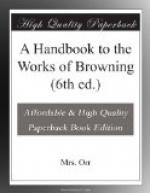Looking back on this experience, the narrator is disposed to regard it as having been a dream. It has nevertheless been a turning-point in his existence; for it has taught him to hear in every blessing which attaches him to the earth, a voice which bids him renounce it. And though he still finds it hard to be a Christian, and is often discouraged by the fact, he welcomes his consciousness of this: since it proves that he is not spiritually stagnating—not cut off from the hope of heaven.
Mr. Browning is, for the time being, outside the discussion. His own feelings might equally have dictated some of the arguments on either side; and although he silences the second speaker, he does not mean to prove him in the wrong. He is at one with the first speaker, when he suggests that certainty in matters of belief is no more to be desired than to be attained; but that personage regards uncertainty as justifying presumptions of a dogmatic kind; while its value to Mr. Browning lies precisely in its right to exclude them. And, again; while the value of spiritual conflict is largely emphasized in his works, he disagrees with the man of faith in “Easter-Day” as with the dogmatic believer in “Christmas-Eve,” as to the manner in which it is to be carried on. According to these the spirit fights against life: according to him it fights in, and by means of, its opportunities. From his point of view human experience is an education: from theirs it is a snare.
So much of personal truth as these poems contain will be found re-stated in “La Saisiaz,” written twenty-eight years later, and which impresses on it the seal of maturer thought and more direct expression.
“LA SAISIAZ” (Savoyard for “The Sun”) is the name of a villa among the mountains near Geneva, where Mr. Browning, with his sister and a friend of many years standing, spent part of the summer of 1877. The poem so christened is addressed to this friend, and was inspired by her death: which took place with appalling suddenness while they were there together. The shock of the event re-opened the great questions which had long before been solved by Mr. Browning’s mind: and within sight of the new-made grave, he re-laid the foundations of his faith, that there is another life for the soul.
The argument is marked by a strong sense of the personal and therefore relative character of human experience and knowledge. It accepts the “subjective synthesis” of some non-theistic thinkers, though excluding, of course, the negations on which this rests; and its greater maturity is shown by the philosophic form in which the author’s old religious doctrine of personal (or subjective) truth has been re-cast. He assumes here, it is true, that God and the soul exist. He considers their existence as given, in the double fact that there is something in us which thinks or perceives,[61] and something outside and beyond us, which is perceived by it; and this subject




